The University of Rochester is one of the country’s top-tier research universities. Our 158 buildings house more than 200 academic majors, more than 2,000 faculty and instructional staff, and some 9,300 students—approximately half of whom are women.
Learning at the University of Rochester is also on a very personal scale. Rochester remains one of the smallest and most collegiate among top research universities, with smaller classes, a low 9:1 student to teacher ratio, and increased interactions with faculty.
About Us
Points of Pride
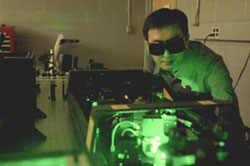 The Institute of Optics was founded in 1929 as the nation’s first educational program devoted exclusively to optics. It is widely considered one of the nation’s premier optics schools and is a leader in basic optical research and theory.
The Institute of Optics was founded in 1929 as the nation’s first educational program devoted exclusively to optics. It is widely considered one of the nation’s premier optics schools and is a leader in basic optical research and theory.
The Laboratory for Laser Energetics’ 60-beam OMEGA laser is the world’s most powerful fusion laser.
When the University pioneered the Take Five Scholars Program two decades ago, it was heralded by the New York Times as “one of the most innovative liberal arts programs in the country.” Since then, the program has allowed more than 900 students to study, tuition free, for an additional semester or year in areas outside their formal majors.
 More people in Rochester have been immunized against bird flu than in any other community in the world, thanks to the University’s role testing bird-flu vaccines. In 2007, a $26 million NIH grant established the University of Rochester Medical Center as one of three national research centers for bird flu and pandemic flu.
More people in Rochester have been immunized against bird flu than in any other community in the world, thanks to the University’s role testing bird-flu vaccines. In 2007, a $26 million NIH grant established the University of Rochester Medical Center as one of three national research centers for bird flu and pandemic flu.
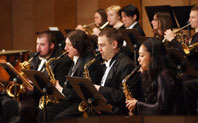 The Eastman School of Music is home to more than 20 student ensembles, including the Eastman Wind Ensemble, the first of its kind in the country and pioneering force in the symphonic wind band movement.
The Eastman School of Music is home to more than 20 student ensembles, including the Eastman Wind Ensemble, the first of its kind in the country and pioneering force in the symphonic wind band movement.
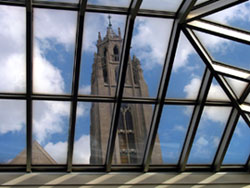 The Memorial Art Gallery has one of the most balanced collections of American art outside of New York City, ranging from the Colonial period to works from living artists. In 2006, the Galley unveiled its reinstalled American Collection. The new installation reflects the major changes that occurred in American art as the young country began to loosen its European ties and expand its notions of the role of art as a reflector and creator of a developing culture.
The Memorial Art Gallery has one of the most balanced collections of American art outside of New York City, ranging from the Colonial period to works from living artists. In 2006, the Galley unveiled its reinstalled American Collection. The new installation reflects the major changes that occurred in American art as the young country began to loosen its European ties and expand its notions of the role of art as a reflector and creator of a developing culture.
 One of only seven carillons in New York State, the 50-bellHopeman Memorial Carillon hangs in the Rush Rhees tower. The carillon sounds every quarter-hour; carillonists play the bells on Wednesdays and during special events.
One of only seven carillons in New York State, the 50-bellHopeman Memorial Carillon hangs in the Rush Rhees tower. The carillon sounds every quarter-hour; carillonists play the bells on Wednesdays and during special events.
Faculty and alumni of the University make up nearly one-quarter of the scientists on the board advising NASA in the development of theJames Webb Space Telescope, which will replace the Hubble Space Telescope in 2011.
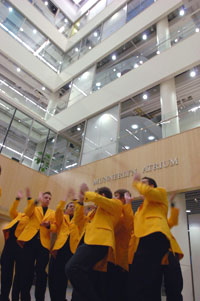 The University’s a cappella ensembles are among the best in the nation. The Yellowjackets celebrated their 50th anniversary in 2006. The Midnight Ramblers finished third in the 2005 International Championship of Collegiate A Cappella (ICCA). And Vocal Point, the University’s all-female a cappella group, won Best Soloist and Best Arrangement at the 2005 ICCAs.
The University’s a cappella ensembles are among the best in the nation. The Yellowjackets celebrated their 50th anniversary in 2006. The Midnight Ramblers finished third in the 2005 International Championship of Collegiate A Cappella (ICCA). And Vocal Point, the University’s all-female a cappella group, won Best Soloist and Best Arrangement at the 2005 ICCAs.
The 18th century Italian Baroque organ, housed  in the Memorial Art Gallery and owned by the Eastman School of Music, is the only full-size antique Italian organ in North America. Weekly organ concerts fill the Gallery’s Herdle Fountain Court with music of the past.
in the Memorial Art Gallery and owned by the Eastman School of Music, is the only full-size antique Italian organ in North America. Weekly organ concerts fill the Gallery’s Herdle Fountain Court with music of the past.
 The Yellowjackets play in the University Athletic Association. The women’s basketball team has played in three of the last four NCAA Division III tournaments, finishing in the Final Four in 2004. The men’s basketball team has played in the last three NCAA championship tournaments, making it to the championship game in 2005. Steven Goodridge became Rochester’s first NCAA champion in golf in 2006. The softball team won its first bid to the NCAA playoffs in 2007.
The Yellowjackets play in the University Athletic Association. The women’s basketball team has played in three of the last four NCAA Division III tournaments, finishing in the Final Four in 2004. The men’s basketball team has played in the last three NCAA championship tournaments, making it to the championship game in 2005. Steven Goodridge became Rochester’s first NCAA champion in golf in 2006. The softball team won its first bid to the NCAA playoffs in 2007.
In 2007, the city of Rochester was named one of the top ten most livable cities in America by the Places Rated Almanac in their 25th anniversary edition. Rochester placed sixth on the list, which evaluates several criteria in making its selections: local economy, recreation, housing, education, health care, transportation, ambiance, crime, and climate.
Recent Rankings
KAPLAN’S
- Kaplan’s 2008 “How to Get Into College” guide lists the Eastman School of Music as the Hottest Music School
- Kaplan’s 2007 guide includes the University of Rochester as one of 25 “New Ivies.”
US NEWS AND WORLD REPORT 2010
- National universities: 35th
- Best graduate schools—School of Engineering and Applied Sciences: 38th
- Best graduate schools—political science: 15th
- Best graduate schools—economics: 22nd
ACADEMIC RANKING OF WORLD UNIVERSITIES (CHINA) 2009
- World universities: 77th
Business Schools
US NEWS AND WORLD REPORT 2010
- Best graduate schools—business: 27th (Simon)
- Best graduate schools—finance: 13th
- Best graduate schools—part-time MBA: 24th
- Best graduate schools—accounting: 31st
FINANCIAL TIMES 2009
- World business schools: 46th (Simon)
WALL STREET JOURNAL 2007
- Nation’s top regional business schools: 4th (Simon)
Medical Schools/Hospitals
US NEWS AND WORLD REPORT 2010
- Best graduate schools—medicine research: 31st
- Best graduate schools—primary care: 15th
US NEWS AND WORLD REPORT 2009: BEST HOSPITALS
- Orthopedics: 25th (Strong Memorial Hospital)
Music Schools
Kaplan’s 2008 “How to Get Into College” guide lists the Eastman School of Music as theHottest Music School
US NEWS AND WORLD REPORT 2004
- Music graduate programs: 1st (Eastman)
Campuses and Landmarks
River Campus (Take a virtual tour)
Location: The 154-acre River Campus—the main campus—is located about two miles south of downtown Rochester, New York, in a bend in the Genesee River.
The Eastman Quadrangle is named for University benefactor and Eastman Kodak founder, George Eastman. The centerpiece of the River Campus, the “Quad” is the academic home of the Faculty of Arts, Sciences and Engineering, defined by the original River Campus buildings—including the landmark Rush Rhees Library—that were opened to students in 1930. The River Campus is also home to the Simon Graduate School of Business Administration and the Warner School of Education.
Rush Rhees Library—The dome of this majestic building, the University’s central library, is the institution’s unofficial symbol and a community landmark. The Hopeman Memorial Carillon, one of only six in New York State and some 180 on the entire continent, is housed here.
Wilson Commons—Student center designed by the internationally renowned architect I. M. Pei includes a stunning six-story glass atrium.
Robert B. Goergen Hall for Biomedical Engineering and Optics—Dedicated in Spring 2007, Goergen Hall is the new home of both the Institute of Optics—founded in 1929, it is the nation’s first academic program in optics—and biomedical engineering—one of the College’s newest and fastest growing departments. Goergen Hall is the first campus building designed with the sustainability standards set by the Leadership in Energy and Environmental Design (LEED) program in mind. For example, all paneling in the building is milled from bamboo, a renewable source of wood; motion detectors throughout the building work with lighting, energy, and air-handling systems to reduce energy use in unoccupied areas; and outside the building a newly created bioretention basin controls runoff and filters pollutants before they can enter the stormwater system.
Robert B. Goergen Athletic Center—Features the Edmund A. Hajim Alumni Gymnasium, an 11,000-square-foot fitness center with state-of-the-art fitness equipment, locker rooms, and a multi-activity center. The athletic center also houses the Louis Alexander Palestra, home for University intercollegiate basketball and volleyball, with permanent seating for 2,200; a field house, with a 200-meter track and synthetic activity infield; the Speegle-Wilbraham Aquatic Center; as well as tennis, squash, and racquetball facilities.
Interfaith Chapel—The tower of this University landmark rises to a point 117 feet above the Genesee River and has 6,500 square feet of colored glass walls—one of the largest glass constructions of its kind in the world.
Medical Center
A nucleus of medical research, education, and patient care, the Medical Center includes the School of Medicine and Dentistry, the School of Nursing, Strong Memorial Hospital, and Eastman Dental Center.
Clinical and Translational Sciences Building—Work is scheduled to begin in 2008 on this 150,000 square foot research and education building on the Medical Center campus.
Arthur Kornberg Medical Research Building—The centerpiece of a $500 million expansion of the School of Medicine and Dentistry’s basic science programs, the 240,000 square-foot Kornberg building was dedicated in 1999 and is home to the Aab Institute of Biomedical Sciences.
Eastman School of Music
Location: Eastman’s downtown campus, located on Gibbs Street, is in the heart of Rochester’s cultural district. In addition to Eastman’s large ensembles, the Rochester Philharmonic Orchestra is based in Eastman Theatre, and the Rochester International Jazz Festival fills venues in and around campus each June.
Eastman Theatre—Since its opening in 1922, the Eastman Theatre has been one of Rochester’s preeminent performance spaces. The 3,094-seat theatre was built by George Eastman as a center for music, dance, and silent film with live orchestral and organ accompaniment. Today, it is the primary performance hall for the Eastman School’s larger orchestras, wind ensembles, jazz ensembles, and chorale.
The renovation of Eastman Theatre stage, the first of two phases of renovations planned for the Theatre, was completed in October 2004. The greatly improved stage includes, among other things, a stunning new custom shell that will enhance acoustics; an improved orchestra pit, with all-new mechanics and hydraulics; new rigging; and improved stage lighting.
Memorial Art Gallery
The Memorial Art Gallery is one of the few university-affiliated art museums in the country that also serve as city art museums, attracting nearly 300,000 visitors a year. The gallery’s permanent collection of 10,000 works spans 50 centuries of world art and includes masterworks by artists such as Monet, Cézanne, Matisse, Homer, and Cassatt.
South Campus
Located one mile south of the Medical Center, South Campus is home to the Laboratory for Laser Energetics (LLE). LLE houses the OMEGA laser, the largest direct-drive laser facility in the world.
The City of Rochester
In 2007, the city of Rochester was named one of the top ten most livable cities in Americaby the Places Ranked Almanac in their 25th anniversary edition. Rochester placed sixth on the list, which evaluates several criteria in making its  selections: local economy, recreation, housing, education, health care, transportation, ambiance, crime, and climate.
selections: local economy, recreation, housing, education, health care, transportation, ambiance, crime, and climate.
Snow is certainly a fact of life here; Rochester averages about 100 inches on snow a year. Winter sports enthusiasts can try their hand at cross-country skiing, snowshoeing, downhill skiing at Bristol Mountain, even curling. There are also plenty of places to escape from the winter weather: take shelter in the city’s coffee shops, restaurants, book stores, movie theaters, and museums. For music lovers, Rochester is home to a surprising number of concert venues for a medium-sized city, from grand theaters to a thriving club scene.
Once the snow melts, Rochesterians head out to the city’s parks and area lakes for some well-earned spring time recreation. Located on the historic Erie Canal and the Genesee River, and just five miles south of Lake Ontario, Rochester offers plenty of sailing, canoeing, and hiking opportunities.
During the spring and summer months, Rochester’s neighborhoods come alive with festivals and arts fairs, including the Lilac Festival in Highland Park, the Park Avenue Festival, the Corn Hill Arts Festival, and the Clothesline Festival at the Memorial Art Gallery.
Rochester has professional baseball (Red Wings), hockey (Amerks), and soccer (Rhinos) teams. And did we mention—there’s a waterfall in the heart of downtown. Regional Transit Service buses, the University shuttle bus, and the UR Special all serve the campus, making the City of Rochester—and all it has to offer—available for students to explore.
Graduate Studies
Outstanding scholarly and professional achievement: These are the goals of graduate study at the University. Admission is selective, the environment intimate and challenging. Here, promising candidates work closely with faculty to develop in-depth knowledge of their chosen fields as they establish themselves as independent, innovative scholars.
OVER 400 ROCHESTER GRADUATES HOLD FACULTY POSITIONS IN SCHOOLS AND PROGRAMS RANKED AMONG THE TOP 25 IN THE NATION.
Included are representatives of almost all of the University’s doctoral programs. A substantial number of graduates have appointments at each of several Ivy League schools (e.g. Harvard, Pennsylvania, and Columbia), other prestigious private universities (e.g. Johns Hopkins, Duke, and Northwestern), and the best public institutions (e.g. UCLA, Michigan, and UC-San Diego).
A list of Rochester alumni on the faculties of these highly ranked schools follows. They are grouped by the institutions at which they have appointments. The list reflects up-to-date information as of the summer of 2007.
Browse through the list and find Rochester Ph.D.s by their discipline groupings.
Find Rochester graduates teaching in … The Humanities Biological Sciences Physical Sciences and Engineering Social Sciences Business Administration Education Music Nursing
* Schools and programs were included if they were among the top 25 as ranked byUS News & World Report; if they were among the top 25 doctoral programs in a discipline as ranked by the National Research Council; if they were among the top 25 national universities in average National Research Council faculty quality rating (reported in the May/June 1996 issue of Change); or if they were among the top 25 universities in terms of the number of disciplines highly ranked.
Leaders in Research and Teaching
Math professor Steve Gonek researches the field of analytic number theory, particularly multiplicative number theory and the distribution of prime numbers
The University of Rochester offers graduate students the chance to pursue research at the highest level in an environment scaled to the individual.
Studying at one of the nation’s leading universities, graduate students at Rochester work closely with faculty who are at the forefront of their fields, and have exceptional opportunities for interdisciplinary study that few universities can match.
The combination of research excellence and personal scale is reflected in the book, The Rise of American Research Universities, (Johns Hopkins University Press: 1997), which ranks Rochester as 12th in research productivity among private universities nationwide when institutional size is taken into account.
People across the country—in academe, but also in the arts, the professions, government, and business—know the University and the strengths of those who study and teach here.
The list of alumni with Rochester graduate degrees includes three Nobel laureates—Arthur Kornberg, M.D. ’41, Vincent du Vigneaud, Ph.D. ’27, and Mastoshi Koshiba, Ph.D. ’55—and three Pulitzer Prize-winners—George Walker, D.M.A. ’56; Galway Kinnell, M.A. ’49; and Dominick Argento, D.M.A. ’58.
Scores of prominent individuals—for example, D. Allan Bromley, Ph.D. ’52, originator of the “Emperor” accelerator concept and director of the White House Office of Science and Technology Policy during the first Bush administration; Ernest D. Courant, Ph.D. ’43, emeritus distinguished scientist at the Brookhaven National Laboratory; Renée Fleming, M.M. ’83, Grammy Award -winning soprano; Bala Manian, M.S. ’69, inventor of many of the technologies that create motion picture special effects; John Rowe M.D. ’70, CEO of Aetna Insurance; Rick Rashid, Ph.D. ’80, senior vice president for research at Microsoft; and Myles Brand, Ph.D. ’67, president of the NCAA—testify to the broad impact the University has had through the accomplishments of its graduate alumni.
Such outstanding graduates learn from distinguished teachers. Rochester’s faculty includes 44 fellows of the American Physical Society, 17 fellows of the Optical Society of America, 14 fellows of the American Academy of Arts and Sciences, 13 fellows of the American Association for the Advancement of Science, and eight fellows of the National Academy of Sciences. Several professors have been officers of the leading academic societies in their fields.
Rochester faculty have received a total of 27 John S. Guggenheim Fellowships in the past 18 years. In the past 10 years they have won six National Endowment for the Humanities Senior Fellowships, and 21 Alfred P. Sloan Research Fellowships.
The faculty includes a recipient of a John D. and Catherine T. MacArthur Foundation Fellowship. Other professors include two recipients of the most prestigious honor of the Optical Society of America, the Frederic Ives Medal; a Distinguished Fellow of the American Economic Association, an honor that goes only to two or three economists each year; and a recipient of the American Physical Society’s Panofsky Prize in Experimental Particle Physics. The American Political Science Association annually awards a prize named in honor of Rochester’s Richard F. Fenno, Jr., professor of political science.
But these distinctions are only part of the story. The University’s libraries, research facilities, departments, and schools each offer unique opportunities for intellectual, scientific, and artistic growth. For example, the Sibley Music Library, in expansive quarters at the Eastman School of Music, is one of the major music research libraries in the world. The Laboratory for Laser Energetics operates the most powerful ultraviolet laser in the world. The Institute of Optics is widely considered the nation’s premier optics school and leads the country in basic optical research.
Evidence of the quality of Rochester’s programs can be found in a variety of sources. For example, the National Research Council’s rankings of doctoral programs lists the Department of Political Science’s training as sixth most effective in the country and the Department of Economics’ as tenth. The 2003 edition of U.S. News & World Report‘s guidebook, America’s Best Graduate Schools, rates Rochester’s music program in the Eastman School as first in the nation. The graduate program in atomic and molecular physics is listed as seventh best. The School of Medicine is ranked 28th overall and 7th in the area of primary care. The American Association of Medical Colleges reports that four of the school’s basic science programs (biochemistry, biostatistics, oral biology, and environmental medicine) rank among the top 15 in their fields in research grants from the National Institutes of Health. In 2003, the Financial Times of London rated the Simon School as third best for both its finance and economics programs and 38nd overall in North America and Europe combined
UNIVERSITY OF ROCHESTER
The University of Rochester (located in Rochester, N.Y.) is one of the nation’s leading private universities. One of the most collegiate in character among members of the Association of American Universities, Rochester has a personal scale that creates exceptional opportunities for interdisciplinary study and close work with faculty. The University consistently ranks among the top colleges and universities nationwide in federally financed science, engineering, medical, and other research.
Admissions | Financial Aid | The College | Departments and Programs | Student Life
VISITING THE UNIVERSITY OF ROCHESTER
The best way to experience what Rochester has to offer is to visit. Tours and interviews are regularly scheduled through the Office of Admissions.
Tours | Virtual Tour and Webcams | Campus Video | Maps and Directions
RECRUITING QUESTIONNAIRES
Each sport has its own recruiting form. These submissions will be reviewed by the sport’s head coach.
Men’s Teams
Baseball
Basketball
Cross-Country
Football
Golf
Soccer
Squash
Swimming & Diving
Tennis
Track & Field
Women’s Teams
Basketball
Cross-Country
Field Hockey
Lacrosse
Soccer
Softball
Swimming & Diving
Tennis
Track & Field
Volleyball
River Campus Sports Complex

Main entrance to the Goergen Athletic Center
The centerpiece of the River Campus Sports Complex is the Goergen Athletic Center, which includes the Hajim Alumni Gymnasium, Zornow Center, Field House, and Palestra. Other facilities around the River Campus include Fauver Stadium, the Peter Lyman Tennis Center, and adjacent grass playing fields.
GOERGEN ATHLETIC CENTER
The Goergen Athletic Center features a 11,000-square-foot Fitness/Weight Facility, locker rooms, a Multi-Activity Center, an atrium, a Central Issue room for equipment, and all departmental offices.

Fitness Center
The Fieldhouse includes a 200 meter indoor running track and synthetic activity infield.
The Speegle-Wilbraham Aquatic Center includes a 25-yard by 25-meter pool and a separate diving well with 1 and 3 meter diving boards and a 300 seat spectator balcony.

Aquatics Center
A lounge and concession area overlook the pool, and there is a large fellowship room for meetings and receptions. A state-of-the-art athletic training facility is also available.
The Louis Alexander Palestra is home to Yellowjacket basketball and volleyball in addition to serving as a venue for University concerts and special events.
The ground floor houses four indoor tennis courts, five international squash courts, 2 racquetball/handball courts, a small aerobics studio and three combination basketball/volleyball courts.
There are also generous locker rooms adjacent to the activity areas.
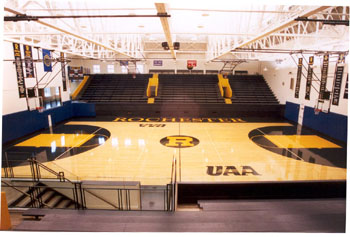
Palestra Interior
FAUVER STADIUM
Fauver Stadium has a lighted AstroTurf playing surface surrounded by an eight lane, 400-meter, all weather Eurotan running track. With seating for 5,000 spectators, this facility is one of the finest in Division III Athletics.
PETER LYMAN TENNIS CENTER
The new Peter Lyman Tennis Center provides six new lighted, outdoor tennis courts adjacent to Hill Court Residence Halls. This facility is available for intercollegiate competition and everyday recreational use.
GRASS PLAYING FIELDS
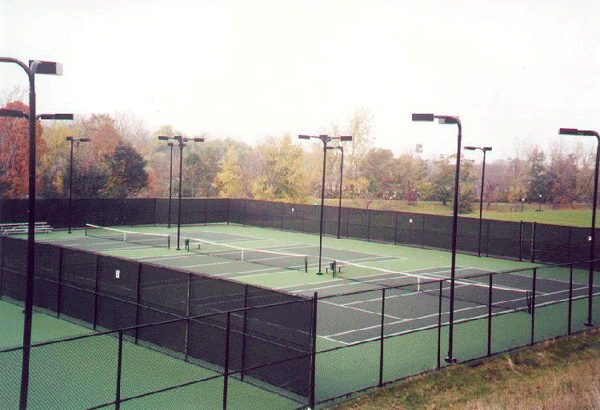
Tennis Center
Towers Field is located between Fauver stadium and Anderson/Wilder Residential Towers. This is the home of our Varsity Baseball program. North Field, which provides a natural grass surface for varsity practice, is adjacent to the Hill Court Residence Halls. The Graduate Living Center (GLC) Field Complex has a varsity practice field, a varsity softball field, a lighted recreational field and a state-of-the-art throwing area for track and field events.
Nearby Genesee Valley Park features two 18-hole public golf courses, more recreational playing fields, an indoor ice skating rink, a 50 meter outdoor swimming pool, and several paved jogging trails. Nominal City of Rochester fees may apply.
Source: University of Rochester
